Nursing Assignment: Leadership Styles and Healthcare Trends
VerifiedAdded on 2023/03/31
|6
|1157
|103
Homework Assignment
AI Summary
This nursing assignment explores various leadership styles within the healthcare context, focusing primarily on adaptive and transformational leadership. The assignment delves into the characteristics of adaptive leadership, its relevance in managing chronic illnesses, and its connection to trait theory. It examines the importance of patient-centered care and the challenges of implementing changes within healthcare organizations. The assignment also analyzes the behavioral perspective of leadership, discussing how leaders' actions and communication influence outcomes. Furthermore, it presents a discussion of two classmates' posts, one focusing on transformational leadership in disaster management and the other on charismatic leadership. The references provided support the concepts discussed, offering insights into the application of different leadership styles in diverse healthcare scenarios and the importance of adapting to evolving healthcare challenges.
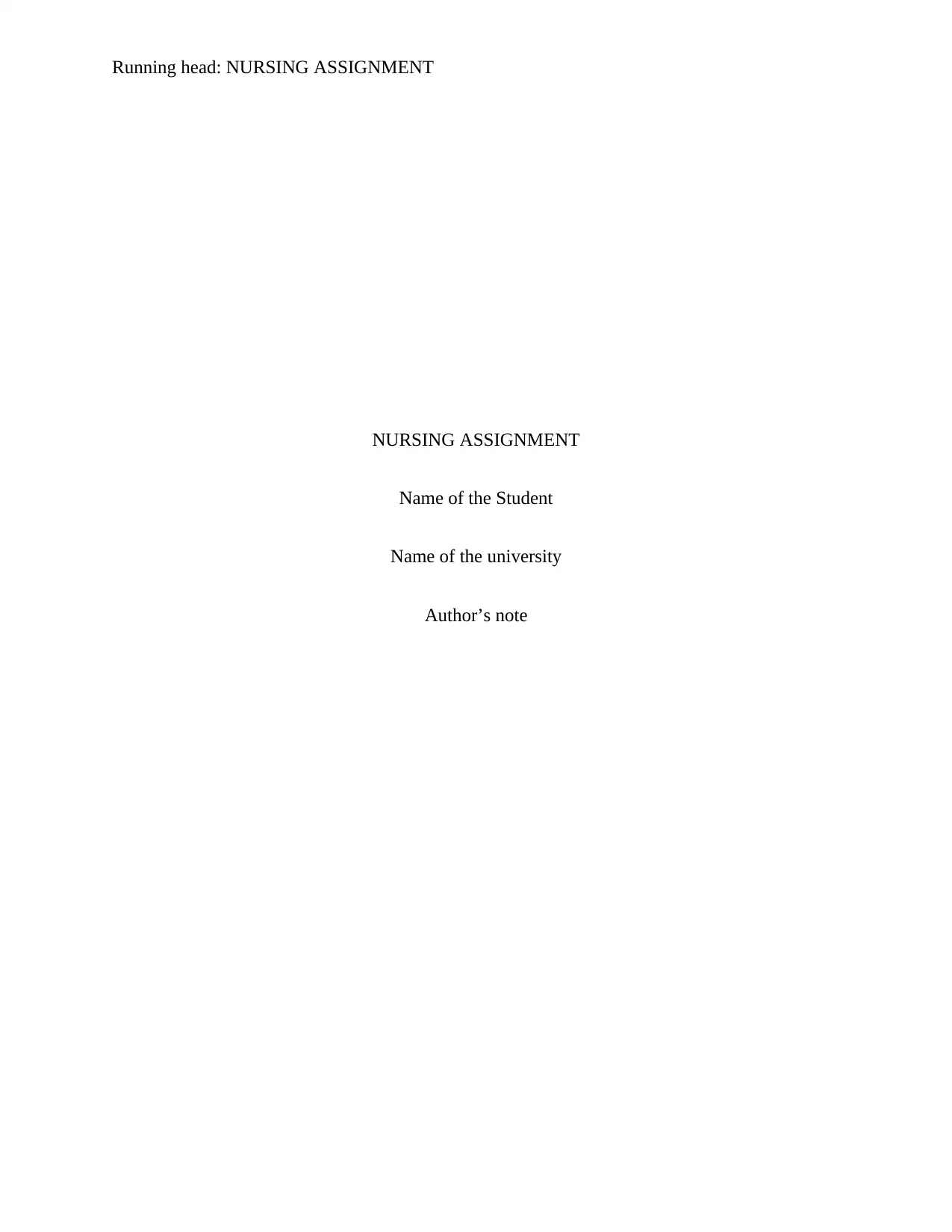
Running head: NURSING ASSIGNMENT
NURSING ASSIGNMENT
Name of the Student
Name of the university
Author’s note
NURSING ASSIGNMENT
Name of the Student
Name of the university
Author’s note
Paraphrase This Document
Need a fresh take? Get an instant paraphrase of this document with our AI Paraphraser

1NURSING ASSIGNMENT
Part 1
There had been an emerging role in one of the leadership style like adaptive leadership that is
suitable in the context of globalised market of health care, with increasing health related
complications and demands. There had been several criticism present regarding the role of the
current literature. Anderson et al.,(2015) has highlighted that health care organisations will never
be able to implement any changes in the organisational level. The paper by Anderson et al.,
(2015) has emphasised on the adaptive leadership framework on the management of chronic
diseases. The key features of an adaptive leadership is the provision of a patient’s centred care.
However once the treatment decisions are made, most of the discussions of the patient centred
care do not extend to working with the patients. In order to mitigate the ill effects of chronic
diseases, adaptive leadership strategies has to developed for responding in a way that is not
within the current repertoire of an individual or a group without practice (Anderson et al.,2015).
Again for adaptive challenges the gap between the goals and the capabilities cannot be bridged
only by the expertise alone. At the fundamental level of the model, it has been depicted, that
symptoms of a chronic illness does not follow a predictable path from the diagnosis through
recovery. In this paper, the adaptive leadership framework not only focuses on the technical
challenges of the patients and the family responses to the illness and the symptoms. For example,
a patient undergoing a chemotherapy can experience mild cognitive impairments such as
working memory, the working speed, visual memory and verbal memory that might interfere
with the verbal memory, which normally would interfere with their ability to multitask in ways
they used in their schools and work. Behavioural leadership focuses on particular behaviour of
the leaders that can only be useful in specific conditions or to bring about certain changes.
Adaptive leadership is a type of behavioural leadership.
Part 1
There had been an emerging role in one of the leadership style like adaptive leadership that is
suitable in the context of globalised market of health care, with increasing health related
complications and demands. There had been several criticism present regarding the role of the
current literature. Anderson et al.,(2015) has highlighted that health care organisations will never
be able to implement any changes in the organisational level. The paper by Anderson et al.,
(2015) has emphasised on the adaptive leadership framework on the management of chronic
diseases. The key features of an adaptive leadership is the provision of a patient’s centred care.
However once the treatment decisions are made, most of the discussions of the patient centred
care do not extend to working with the patients. In order to mitigate the ill effects of chronic
diseases, adaptive leadership strategies has to developed for responding in a way that is not
within the current repertoire of an individual or a group without practice (Anderson et al.,2015).
Again for adaptive challenges the gap between the goals and the capabilities cannot be bridged
only by the expertise alone. At the fundamental level of the model, it has been depicted, that
symptoms of a chronic illness does not follow a predictable path from the diagnosis through
recovery. In this paper, the adaptive leadership framework not only focuses on the technical
challenges of the patients and the family responses to the illness and the symptoms. For example,
a patient undergoing a chemotherapy can experience mild cognitive impairments such as
working memory, the working speed, visual memory and verbal memory that might interfere
with the verbal memory, which normally would interfere with their ability to multitask in ways
they used in their schools and work. Behavioural leadership focuses on particular behaviour of
the leaders that can only be useful in specific conditions or to bring about certain changes.
Adaptive leadership is a type of behavioural leadership.
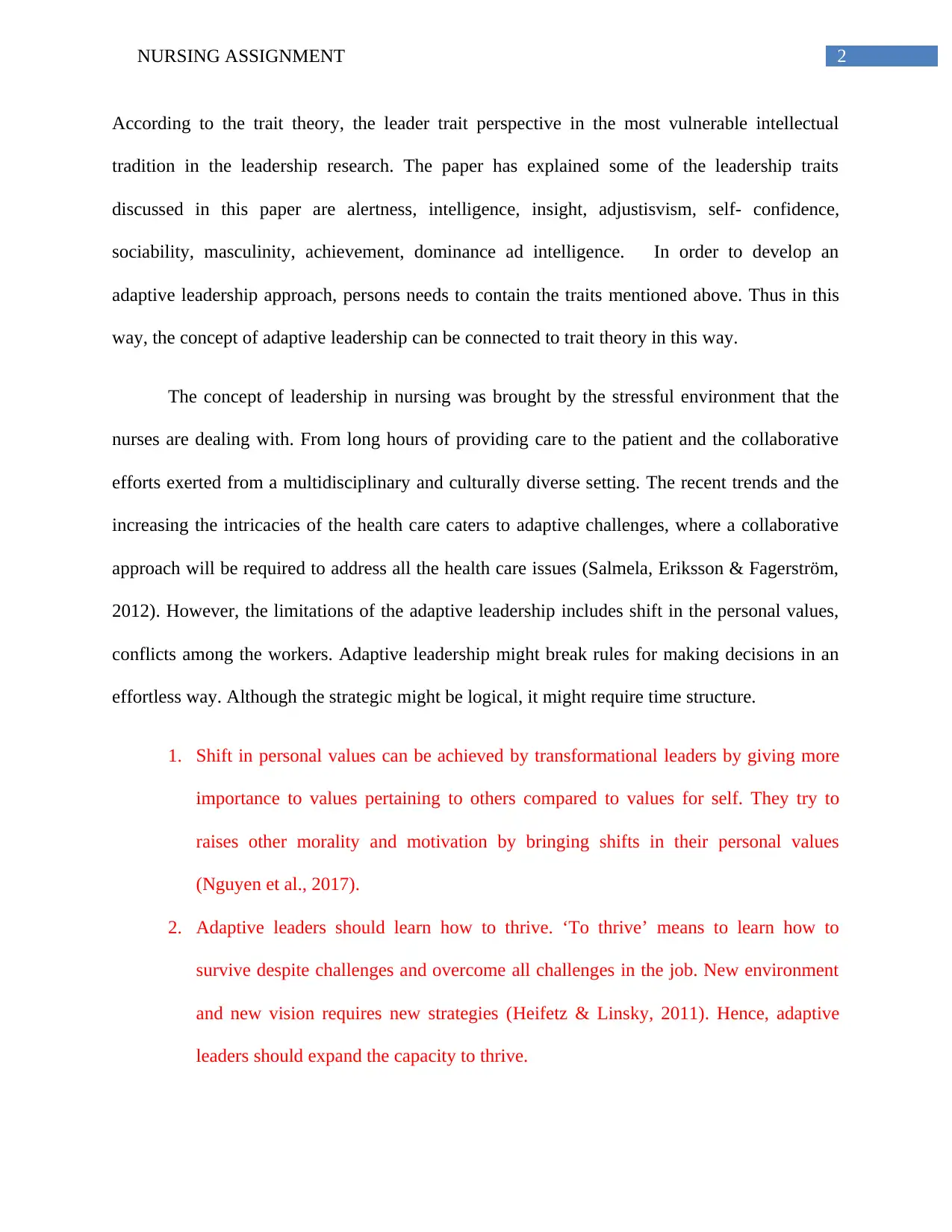
2NURSING ASSIGNMENT
According to the trait theory, the leader trait perspective in the most vulnerable intellectual
tradition in the leadership research. The paper has explained some of the leadership traits
discussed in this paper are alertness, intelligence, insight, adjustisvism, self- confidence,
sociability, masculinity, achievement, dominance ad intelligence. In order to develop an
adaptive leadership approach, persons needs to contain the traits mentioned above. Thus in this
way, the concept of adaptive leadership can be connected to trait theory in this way.
The concept of leadership in nursing was brought by the stressful environment that the
nurses are dealing with. From long hours of providing care to the patient and the collaborative
efforts exerted from a multidisciplinary and culturally diverse setting. The recent trends and the
increasing the intricacies of the health care caters to adaptive challenges, where a collaborative
approach will be required to address all the health care issues (Salmela, Eriksson & Fagerström,
2012). However, the limitations of the adaptive leadership includes shift in the personal values,
conflicts among the workers. Adaptive leadership might break rules for making decisions in an
effortless way. Although the strategic might be logical, it might require time structure.
1. Shift in personal values can be achieved by transformational leaders by giving more
importance to values pertaining to others compared to values for self. They try to
raises other morality and motivation by bringing shifts in their personal values
(Nguyen et al., 2017).
2. Adaptive leaders should learn how to thrive. ‘To thrive’ means to learn how to
survive despite challenges and overcome all challenges in the job. New environment
and new vision requires new strategies (Heifetz & Linsky, 2011). Hence, adaptive
leaders should expand the capacity to thrive.
According to the trait theory, the leader trait perspective in the most vulnerable intellectual
tradition in the leadership research. The paper has explained some of the leadership traits
discussed in this paper are alertness, intelligence, insight, adjustisvism, self- confidence,
sociability, masculinity, achievement, dominance ad intelligence. In order to develop an
adaptive leadership approach, persons needs to contain the traits mentioned above. Thus in this
way, the concept of adaptive leadership can be connected to trait theory in this way.
The concept of leadership in nursing was brought by the stressful environment that the
nurses are dealing with. From long hours of providing care to the patient and the collaborative
efforts exerted from a multidisciplinary and culturally diverse setting. The recent trends and the
increasing the intricacies of the health care caters to adaptive challenges, where a collaborative
approach will be required to address all the health care issues (Salmela, Eriksson & Fagerström,
2012). However, the limitations of the adaptive leadership includes shift in the personal values,
conflicts among the workers. Adaptive leadership might break rules for making decisions in an
effortless way. Although the strategic might be logical, it might require time structure.
1. Shift in personal values can be achieved by transformational leaders by giving more
importance to values pertaining to others compared to values for self. They try to
raises other morality and motivation by bringing shifts in their personal values
(Nguyen et al., 2017).
2. Adaptive leaders should learn how to thrive. ‘To thrive’ means to learn how to
survive despite challenges and overcome all challenges in the job. New environment
and new vision requires new strategies (Heifetz & Linsky, 2011). Hence, adaptive
leaders should expand the capacity to thrive.
⊘ This is a preview!⊘
Do you want full access?
Subscribe today to unlock all pages.

Trusted by 1+ million students worldwide
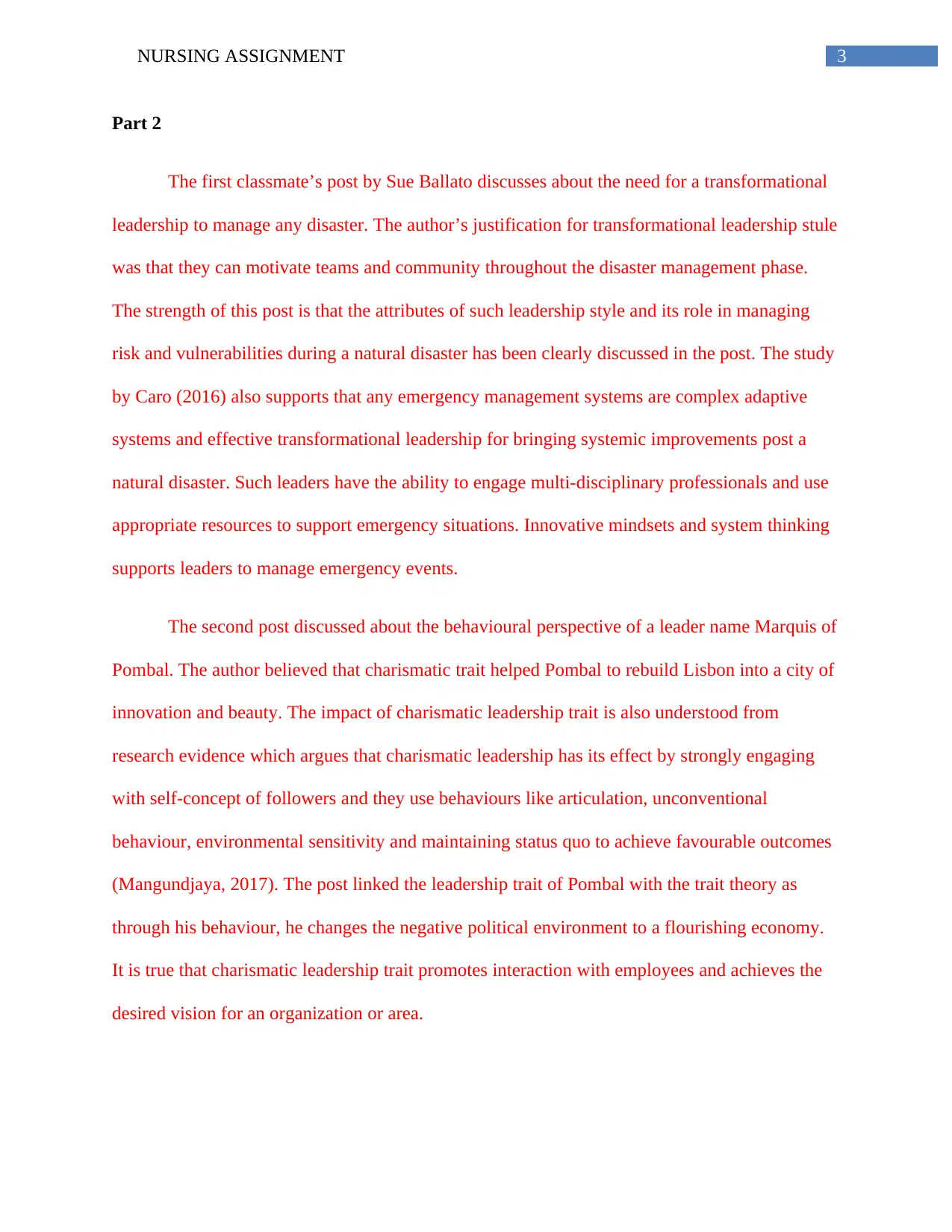
3NURSING ASSIGNMENT
Part 2
The first classmate’s post by Sue Ballato discusses about the need for a transformational
leadership to manage any disaster. The author’s justification for transformational leadership stule
was that they can motivate teams and community throughout the disaster management phase.
The strength of this post is that the attributes of such leadership style and its role in managing
risk and vulnerabilities during a natural disaster has been clearly discussed in the post. The study
by Caro (2016) also supports that any emergency management systems are complex adaptive
systems and effective transformational leadership for bringing systemic improvements post a
natural disaster. Such leaders have the ability to engage multi-disciplinary professionals and use
appropriate resources to support emergency situations. Innovative mindsets and system thinking
supports leaders to manage emergency events.
The second post discussed about the behavioural perspective of a leader name Marquis of
Pombal. The author believed that charismatic trait helped Pombal to rebuild Lisbon into a city of
innovation and beauty. The impact of charismatic leadership trait is also understood from
research evidence which argues that charismatic leadership has its effect by strongly engaging
with self-concept of followers and they use behaviours like articulation, unconventional
behaviour, environmental sensitivity and maintaining status quo to achieve favourable outcomes
(Mangundjaya, 2017). The post linked the leadership trait of Pombal with the trait theory as
through his behaviour, he changes the negative political environment to a flourishing economy.
It is true that charismatic leadership trait promotes interaction with employees and achieves the
desired vision for an organization or area.
Part 2
The first classmate’s post by Sue Ballato discusses about the need for a transformational
leadership to manage any disaster. The author’s justification for transformational leadership stule
was that they can motivate teams and community throughout the disaster management phase.
The strength of this post is that the attributes of such leadership style and its role in managing
risk and vulnerabilities during a natural disaster has been clearly discussed in the post. The study
by Caro (2016) also supports that any emergency management systems are complex adaptive
systems and effective transformational leadership for bringing systemic improvements post a
natural disaster. Such leaders have the ability to engage multi-disciplinary professionals and use
appropriate resources to support emergency situations. Innovative mindsets and system thinking
supports leaders to manage emergency events.
The second post discussed about the behavioural perspective of a leader name Marquis of
Pombal. The author believed that charismatic trait helped Pombal to rebuild Lisbon into a city of
innovation and beauty. The impact of charismatic leadership trait is also understood from
research evidence which argues that charismatic leadership has its effect by strongly engaging
with self-concept of followers and they use behaviours like articulation, unconventional
behaviour, environmental sensitivity and maintaining status quo to achieve favourable outcomes
(Mangundjaya, 2017). The post linked the leadership trait of Pombal with the trait theory as
through his behaviour, he changes the negative political environment to a flourishing economy.
It is true that charismatic leadership trait promotes interaction with employees and achieves the
desired vision for an organization or area.
Paraphrase This Document
Need a fresh take? Get an instant paraphrase of this document with our AI Paraphraser
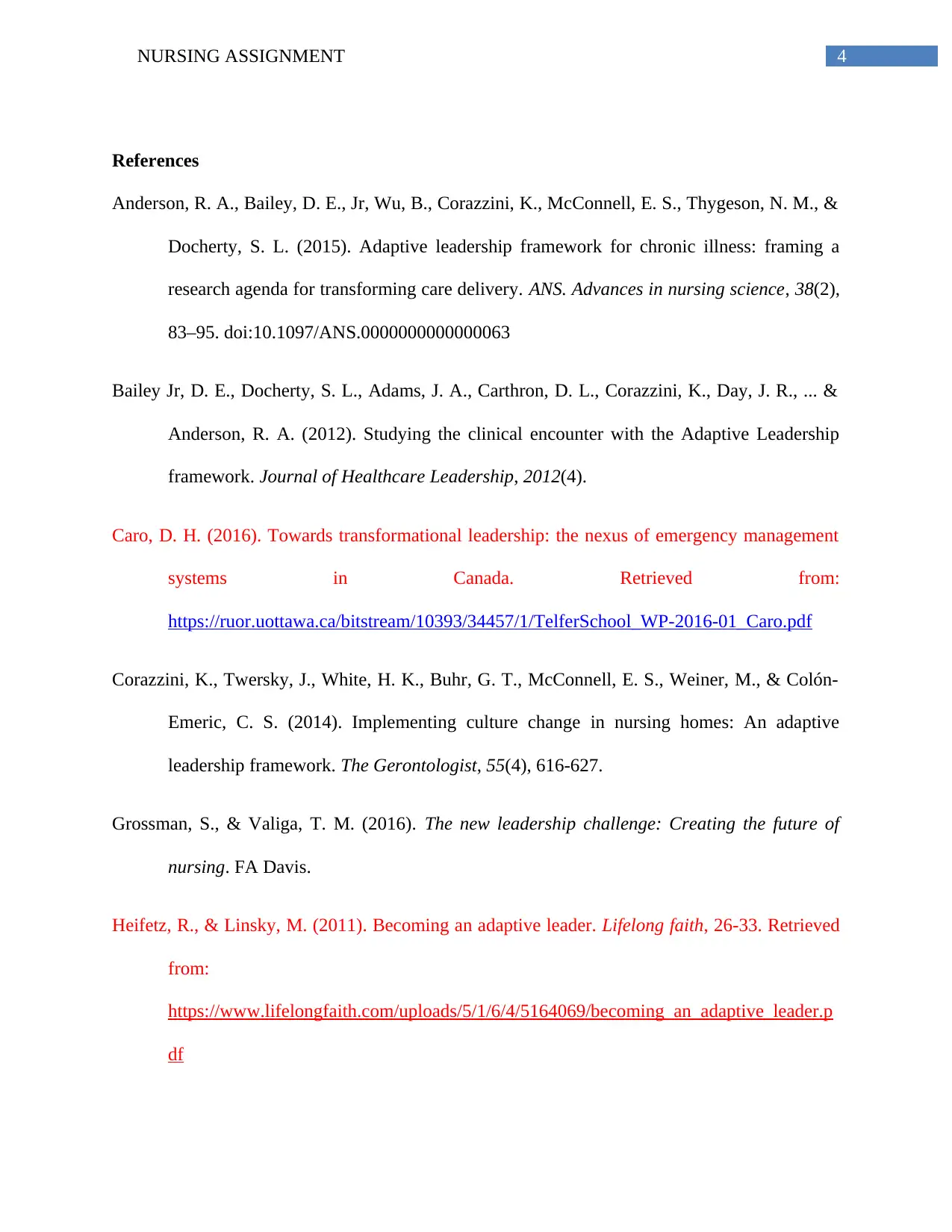
4NURSING ASSIGNMENT
References
Anderson, R. A., Bailey, D. E., Jr, Wu, B., Corazzini, K., McConnell, E. S., Thygeson, N. M., &
Docherty, S. L. (2015). Adaptive leadership framework for chronic illness: framing a
research agenda for transforming care delivery. ANS. Advances in nursing science, 38(2),
83–95. doi:10.1097/ANS.0000000000000063
Bailey Jr, D. E., Docherty, S. L., Adams, J. A., Carthron, D. L., Corazzini, K., Day, J. R., ... &
Anderson, R. A. (2012). Studying the clinical encounter with the Adaptive Leadership
framework. Journal of Healthcare Leadership, 2012(4).
Caro, D. H. (2016). Towards transformational leadership: the nexus of emergency management
systems in Canada. Retrieved from:
https://ruor.uottawa.ca/bitstream/10393/34457/1/TelferSchool_WP-2016-01_Caro.pdf
Corazzini, K., Twersky, J., White, H. K., Buhr, G. T., McConnell, E. S., Weiner, M., & Colón-
Emeric, C. S. (2014). Implementing culture change in nursing homes: An adaptive
leadership framework. The Gerontologist, 55(4), 616-627.
Grossman, S., & Valiga, T. M. (2016). The new leadership challenge: Creating the future of
nursing. FA Davis.
Heifetz, R., & Linsky, M. (2011). Becoming an adaptive leader. Lifelong faith, 26-33. Retrieved
from:
https://www.lifelongfaith.com/uploads/5/1/6/4/5164069/becoming_an_adaptive_leader.p
df
References
Anderson, R. A., Bailey, D. E., Jr, Wu, B., Corazzini, K., McConnell, E. S., Thygeson, N. M., &
Docherty, S. L. (2015). Adaptive leadership framework for chronic illness: framing a
research agenda for transforming care delivery. ANS. Advances in nursing science, 38(2),
83–95. doi:10.1097/ANS.0000000000000063
Bailey Jr, D. E., Docherty, S. L., Adams, J. A., Carthron, D. L., Corazzini, K., Day, J. R., ... &
Anderson, R. A. (2012). Studying the clinical encounter with the Adaptive Leadership
framework. Journal of Healthcare Leadership, 2012(4).
Caro, D. H. (2016). Towards transformational leadership: the nexus of emergency management
systems in Canada. Retrieved from:
https://ruor.uottawa.ca/bitstream/10393/34457/1/TelferSchool_WP-2016-01_Caro.pdf
Corazzini, K., Twersky, J., White, H. K., Buhr, G. T., McConnell, E. S., Weiner, M., & Colón-
Emeric, C. S. (2014). Implementing culture change in nursing homes: An adaptive
leadership framework. The Gerontologist, 55(4), 616-627.
Grossman, S., & Valiga, T. M. (2016). The new leadership challenge: Creating the future of
nursing. FA Davis.
Heifetz, R., & Linsky, M. (2011). Becoming an adaptive leader. Lifelong faith, 26-33. Retrieved
from:
https://www.lifelongfaith.com/uploads/5/1/6/4/5164069/becoming_an_adaptive_leader.p
df
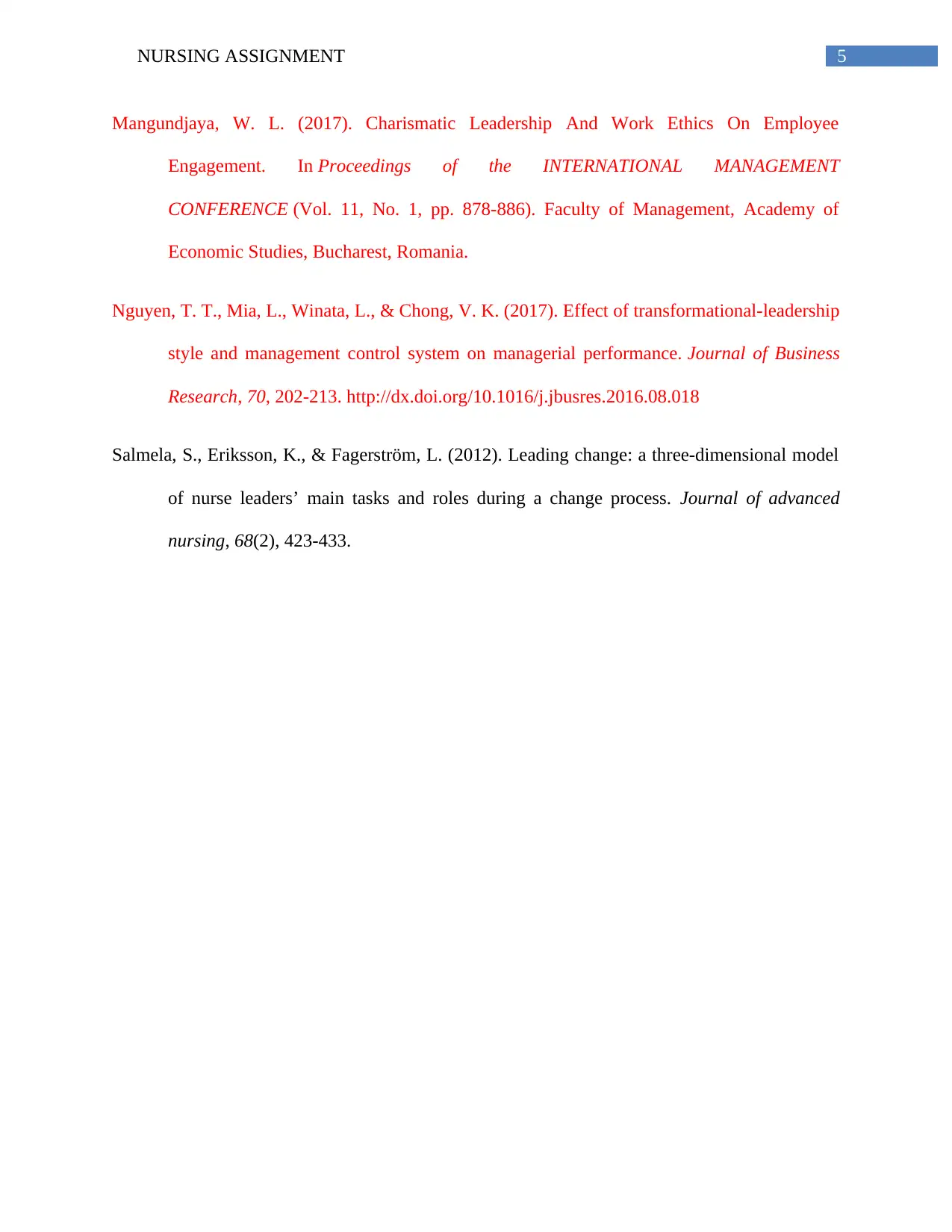
5NURSING ASSIGNMENT
Mangundjaya, W. L. (2017). Charismatic Leadership And Work Ethics On Employee
Engagement. In Proceedings of the INTERNATIONAL MANAGEMENT
CONFERENCE (Vol. 11, No. 1, pp. 878-886). Faculty of Management, Academy of
Economic Studies, Bucharest, Romania.
Nguyen, T. T., Mia, L., Winata, L., & Chong, V. K. (2017). Effect of transformational-leadership
style and management control system on managerial performance. Journal of Business
Research, 70, 202-213. http://dx.doi.org/10.1016/j.jbusres.2016.08.018
Salmela, S., Eriksson, K., & Fagerström, L. (2012). Leading change: a three‐dimensional model
of nurse leaders’ main tasks and roles during a change process. Journal of advanced
nursing, 68(2), 423-433.
Mangundjaya, W. L. (2017). Charismatic Leadership And Work Ethics On Employee
Engagement. In Proceedings of the INTERNATIONAL MANAGEMENT
CONFERENCE (Vol. 11, No. 1, pp. 878-886). Faculty of Management, Academy of
Economic Studies, Bucharest, Romania.
Nguyen, T. T., Mia, L., Winata, L., & Chong, V. K. (2017). Effect of transformational-leadership
style and management control system on managerial performance. Journal of Business
Research, 70, 202-213. http://dx.doi.org/10.1016/j.jbusres.2016.08.018
Salmela, S., Eriksson, K., & Fagerström, L. (2012). Leading change: a three‐dimensional model
of nurse leaders’ main tasks and roles during a change process. Journal of advanced
nursing, 68(2), 423-433.
⊘ This is a preview!⊘
Do you want full access?
Subscribe today to unlock all pages.

Trusted by 1+ million students worldwide
1 out of 6
Related Documents
Your All-in-One AI-Powered Toolkit for Academic Success.
+13062052269
info@desklib.com
Available 24*7 on WhatsApp / Email
![[object Object]](/_next/static/media/star-bottom.7253800d.svg)
Unlock your academic potential
Copyright © 2020–2025 A2Z Services. All Rights Reserved. Developed and managed by ZUCOL.





